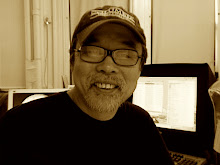For those two years, Keum read the book so many times, he could remember the whole book page by page, problem by problem and he could solve almost all of them with his eyes closed.
For those two years, he hardly talked to anyone except the occasional yes and no's to his teachers and his mother. In the classes at school, he completely shut down himself, so naturally his classmates treated him like a weirdo; he became a biggest 'wang-dda' in school's history. Wang-dda, in Korean, means a 'lone weirdo'. Once you are labeled as 'wang-dda', you become a target of all kinds of abuse from class bullies. You might know children at that age could be real cruel. But any kind cruel abuses didn't make him to talk. The more abused, the less he responded.
After a while, the bullies gave up on him and moved to find another target, left him alone.
He didn't know that the immense feelings of dislike toward his father caused all that but he was too young to know then.
On a normal day, he would wake up at 6 in the morning. He would find breakfast on the wooden table, left by his mother before she went out to open her restaurant. While eating, he would put the imaginary baduk stones on one corner of the table and play out the problems from the book (there were no baduk stones). If anyone saw what he did, the person surely would think that the boy was crazy.
On the year when he became twelve years old, there was a big change in the city he lived; the government approved the plan of making new international airport in the harbor of Incheon, not just an airport, but the largest one in Asia. Even though the Incheon International Airport(ICN) wasn't completed until fifteen years later, the idea was popular among Incheonians because the new-largest-in-Asia-airport meant more jobs and once in life time opportunity of making big money to many of them. The city's mayor was extremely satisfied. He held series of events to celebrate the approval of the airport. Many soccer, baseball, basketball games were played to celebrate. Ssi-rum competitions (Korean traditional wrestling) were held and champions went home with 3-year-old-prize-bulls. There were karaoke contests. And some people even held private poker games.
Schools held similar events like mathematics and English competition. There were track and field games at every school. There was a Quiz show called 'Incheon Junior High Schools' Who, What, How, Where and Why Quiz Show Celebrating Coming Incheon International Airport.' The manager of the show later was fired because of the too long title of the show, people said.
One of such events was this tiny tournament at each and every libraries at elementary schools on weekends of Summer. It was called Incheon Childrens Guksu-jun; Baduk King Tournament.
Baduk had been the national game since Guksu Cho Nam Chul* (The King of Baduk, master Cho Namchul) distributed and popularized the game.
Keum was visiting Mrs. Paik at the time of the tournament and for the first time he watched the real games played between players. Most games were between low grade players and he found they all looked boring. Except at one table where many people watching. Two players were strongest 12 year olds from his school.
The game was well into mid-game stage and a big fight was going on. It was black's turn to make a move and he hadn't made a move for good twenty minutes. On the far end of the library, tournament officers set up a large magnetic badk-pan and replayed the on-going game. One of the pros who was born in Incheon was showing possible best moves for the situation. Keum looked at the situation on the magnetic board, and right away noticed the sequence which black could kill white dragon. The pro asked the audience if anyone could come up with the correct answer. No one could. The pro repeated the same question few times until, to everyone's surprize, the school's well known'wang-dda raised his hand.
The pro smiled and asked the boy to come up to the board and play the sequence.
Keum walked up and put large magnetic stones on the board. He was shy but not nervous. When he did it, it was so fast and with such force each move made loud clinking noise.
-----------------------------------------------------------
[*http://en.wikipedia.org/wiki/Cho_Namchul: Cho was born in a farming village in Buan, North Jeolla Province. In 1934, Japanese professional Kitani Minoru visited Korea and played with ten-year-old Cho, who deeply impressed the great master. He went to Japan in 1937 to study go as Kitani's first insei, or live-in student. In 1943, he returned to South Korea and played a key role in the founding of the Hanguk Kiwon. It wasn't until 1983, that he would be awarded 9 dan, but for most of the 1950's and 1960's, he won the vast majority of national tournaments.
He is known as the founder of Korean modern Go.
After his death, he was honored by the president of Korea with a medal and floral tribute.]
Wednesday, March 19, 2008
Subscribe to:
Posts (Atom)
